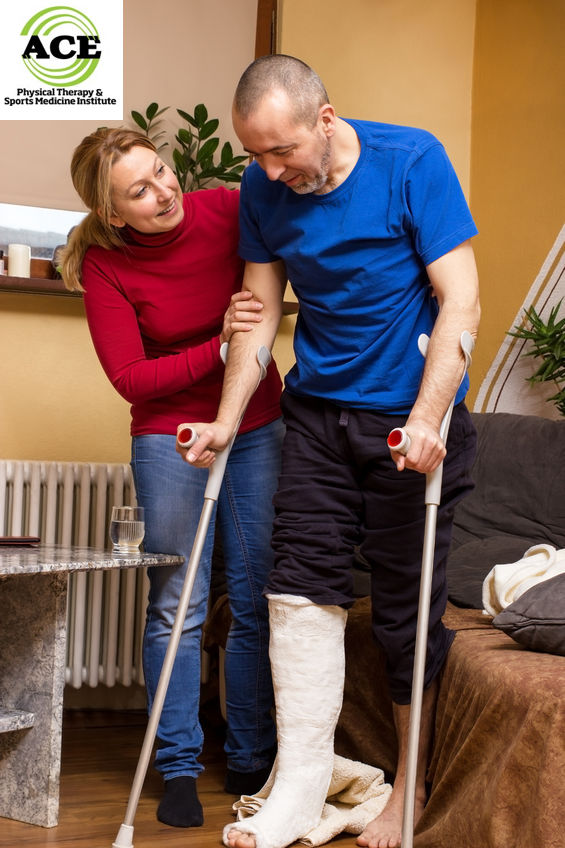HOW DOES A BROKEN BONE HEAL?

Tid Bits of Info
- Human bones will heal in approximately 6-8 weeks.
- The thigh bone, Femur, is the strongest bone in the body and can withstand forces up to approximately 2500 lbs.
- The lateral ankle bone, Fibula, is the most commonly fractured bone.
- Bone remodels throughout life, osteoclasts break down old bone and osteoblasts produce new bone cells.
- Seek the advice and treatment of a Physical Therapist to restore your function after a fractured bone heals.
Bones break. One person falls to the ground. Another gets hit so hard by a baseball that the wrist bone breaks. Bones break but they also heal. Did you ever wonder how a bone heals itself? There are several stages that take place during the healing process and if all goes well the bone usually heals itself within 6-8 weeks.
Human bone is one of the hardest structures in the human body. The rigidity of the bone enables it to withstand tremendous stress and strains of many kinds and from many directions. Unlike most hard objects such as glass and stone, healthy bone has an elastic component to its characteristics. This elasticity, due to collagen, enables the bone to deform and slightly change shape without breaking.
Withstanding force is a property resulting from the bone’s composite of organic and inorganic material. The bone is constantly remodeling itself, and it will react positively or negatively to the mechanical load that is placed upon it. When the load is heavy the bone will respond by producing more bone and when there is disuse the bone will lose bone material.
The health status of human bones and their ability to withstand stress and strain is reliant upon several factors. Age, gender, part of the body, mineral/water content and disease such as osteoporosis can affect the health of the bone. The health of the bone prior to any fracture will determine how long it takes to heal if it is broken.
When someone’s bone is subjected to enough force it will break or fracture. In a healthy individual (with no health conditions that will slow down the healing time) the bone should heal completely in roughly 8 weeks.
The healing process of a broken bone can be separated into three stages. The inflammatory stage, repair stage and remodeling stage make up the entire process and once complete the bone has been restored to its original physical and mechanical status.
The inflammatory stage begins immediately following the occurrence of a fracture. A hematoma forms within hours to a few days and the inflammatory cells infiltrate the bone. This enables new tissue to develop that prepares the bone to produce new bone cells. Vascular tissue is developed and enables the new bone growth to be “nourished” with blood flow. Necessary nutrients and oxygen are present in the area of new bone.
The second stage, repair, is the stage that the first new bone cells are present. The vascular tissue begins to have a collagen matrix develop with in it and a soft callus is formed around the fracture. The callus is very weak and poorly formed for the first 4 weeks.
The last stage, remodeling, is the stage when the bone completely heals and is restored to its original properties. The bone will continue to remodel itself for its lifetime, providing it remains healthy. Mechanical stresses that are placed upon it will initiate more bone growth. Immobility is needed in the beginning to allow the callus to form, but a transition out of the splint or cast is needed to enable the final remodeling stage to be completed.

The fracture of a long bone usually requires a period of immobility. The immobility can create a host of orthopeadic problems such as joint stiffness, muscle atrophy, cartilage softening and surrounding bone osteopenia/osteoporosis. In many cases the immobility creates more issues than the original fracture site. The conditions that can occur with prolonged immobility have lead orthopaedic doctors to develop protocols and treatment techniques that enable a fracture site to be moved more readily than in the past. It is rare for someone to be in a completely immobilized state for more that 3-4 weeks.
Your orthopaedic doctor will have you attend Physical Therapy when you are capable of moving the fracture site without fear of re-injuring the healing bone. The Physical Therapist will help you reduce swelling and pain, restore motion and begin the long process of developing enough strength and neuromuscular control to regain full functional use of the injured body part.
Human bones are capable of withstanding a tremendous amount of force and can adapt its shape to handle it, but there is literally a “breaking point”. If the bone fractures it will heal. The healing time is dependent upon the overall health of the individual, but in the “healthy” population the bone should return to its pre-fracture status within 8 weeks. A thorough rehabilitation program that is supervised by a Physical Therapist will be needed to restore the full functional capabilities of the involved body parts.

























This article reminds me of my two patients with stress fractures of their metatarsal bones. Both of them are female in same age categories, however, the healing time and the rehab process has been different for these patients. The approximate healing time for a fractured bone is 6-8 weeks, however, there are other factors that could play a role in the healing process and make it faster or longer. One of which is the type of fracture and whether the fracture needed surgical fixation or not. Also, an open fracture that exposes bone to different types of bacteria could lengthen the healing process. Location of the fracture and whether it is intra or extra-articular could definitely affect the healing time. Different medications and their role in calcium resorption or uptake, metabolic diseases such as diabetes, hyperparathyroidism, osteoprosis, Cushing’s syndrome or diseases that have an effect on collagen synthesis such as osteogenesis imperfecta are just a few reasons why the healing time could be different from person to person. As a physical therapist not only we should encourage our patients to move and lead them through a successful healing process, we need to have a general idea of each patient’s medical condition to have a better estimate of their rehab potentials, and the time needed for them to get back to their prior level of function and then guide them through a rehabilitation program that has been tailored to their individual condition.
I have worked with individuals in rehab with broken tibias. I have never broken a bone so this article has helped me empathize even more with them. Apparently the pain is significant and it is difficult to categorize that as good or normal when transitioning to weight bearing. Since the lower leg (shin) doesn’t have many muscles to it there is less blood supply which delays even more the healing for this particular bone but also makes it imperative that weigh bearing occur to rebuild the muscles that atrophy with the casting to ensure good blood supply. It was good to review the general timeline for bone healing.
I think it’s a great idea to participate in physical therapy following a break or immobilization, but I don’t think it is standard practice yet for all orthopedists. As a patient, it’s important to know when to advocate for yourself or seek PT via direct access.
So when is PT a must? If you: are fearful of movement/ weight bearing, noticing a significant loss of movement in the immobilized segment, have marked atrophy, are using other body parts/movements to compensate, or having significant pain.
Patients are always concerned after a break how long until they are able to be up and weight bearing on the joint. Joint loading is the best way for a bone to heal however initially in the first 6-8 weeks you need to have the above inflammatory process occur to allow for proper union and for calcification of the bone to occur. Generally an X-ray is performed before weight bearing status is addressed because they look for the calcification of a soft callus to a hard callus that is able to endure the weight bearing of daily life. Many factors can also contribute to bone healing and inflammatory process; medications, diet/nutrition, and obeying by weight bearing precautions to allow the bone to fixate and heal.